Accounting and Finance Report: RACCA, RECKTURK, ROCKHAM PLC Analysis
VerifiedAdded on 2023/01/11
|22
|3891
|60
Report
AI Summary
This report offers a detailed analysis of accounting and finance principles, focusing on the financial performance and strategic decisions of RACCA Limited, RECKTURK PLC, and ROCKHAM PLC. The report begins with the preparation of a profit and loss statement and balance sheet for RACCA Limited, providing insights into its financial position. It then delves into RECKTURK PLC, calculating contribution per unit, break-even points, margin of safety, and profit analysis under different scenarios. Furthermore, the report assesses the company's strategy, including an examination of break-even model assumptions. Finally, the report evaluates capital budgeting projects for ROCKHAM PLC using investment appraisal techniques such as payback period, accounting rate of return (ARR), and net present value (NPV), providing recommendations based on the analysis. The report also discusses the merits and limitations of these techniques and the use of budgets as a strategic planning tool.
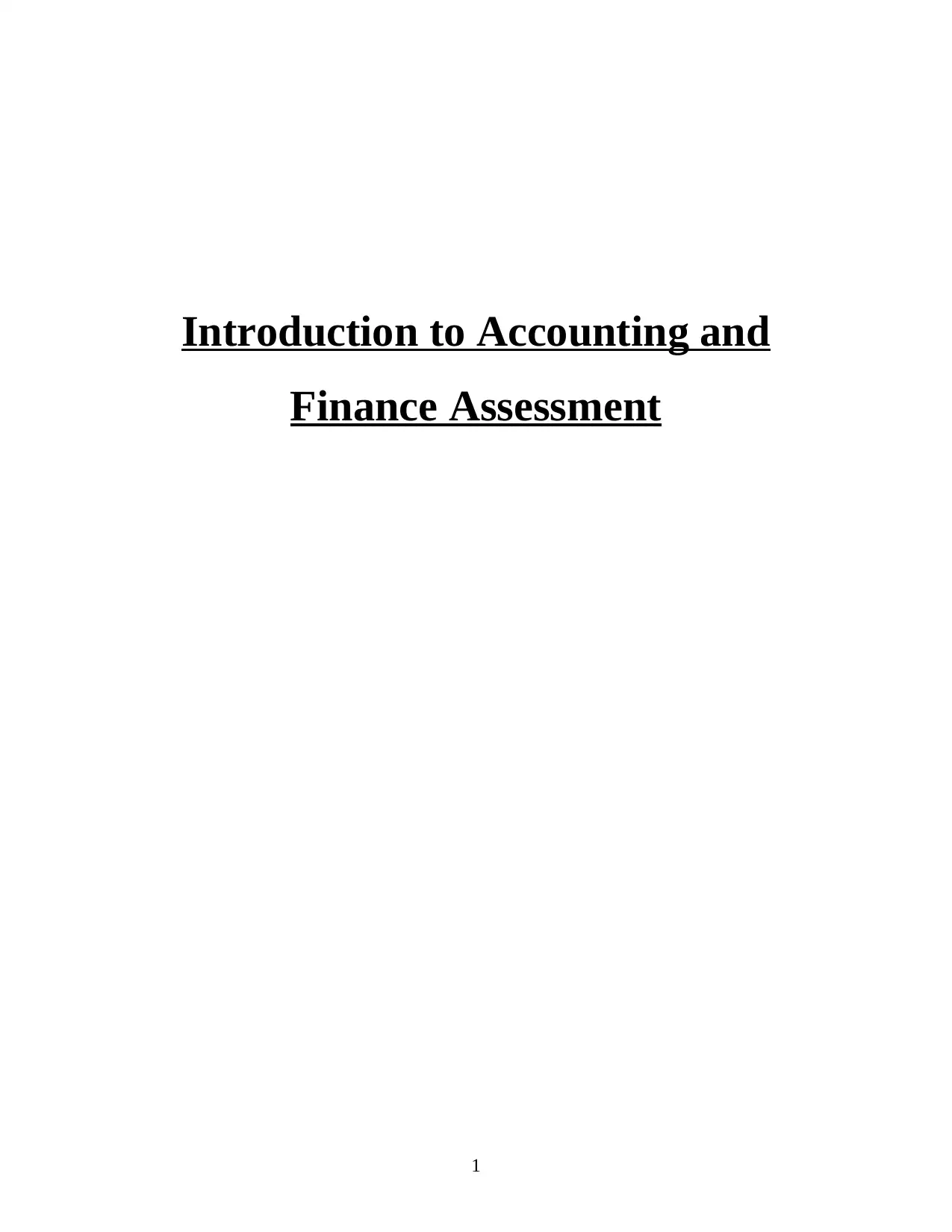
Introduction to Accounting and
Finance Assessment
1
Finance Assessment
1
Paraphrase This Document
Need a fresh take? Get an instant paraphrase of this document with our AI Paraphraser
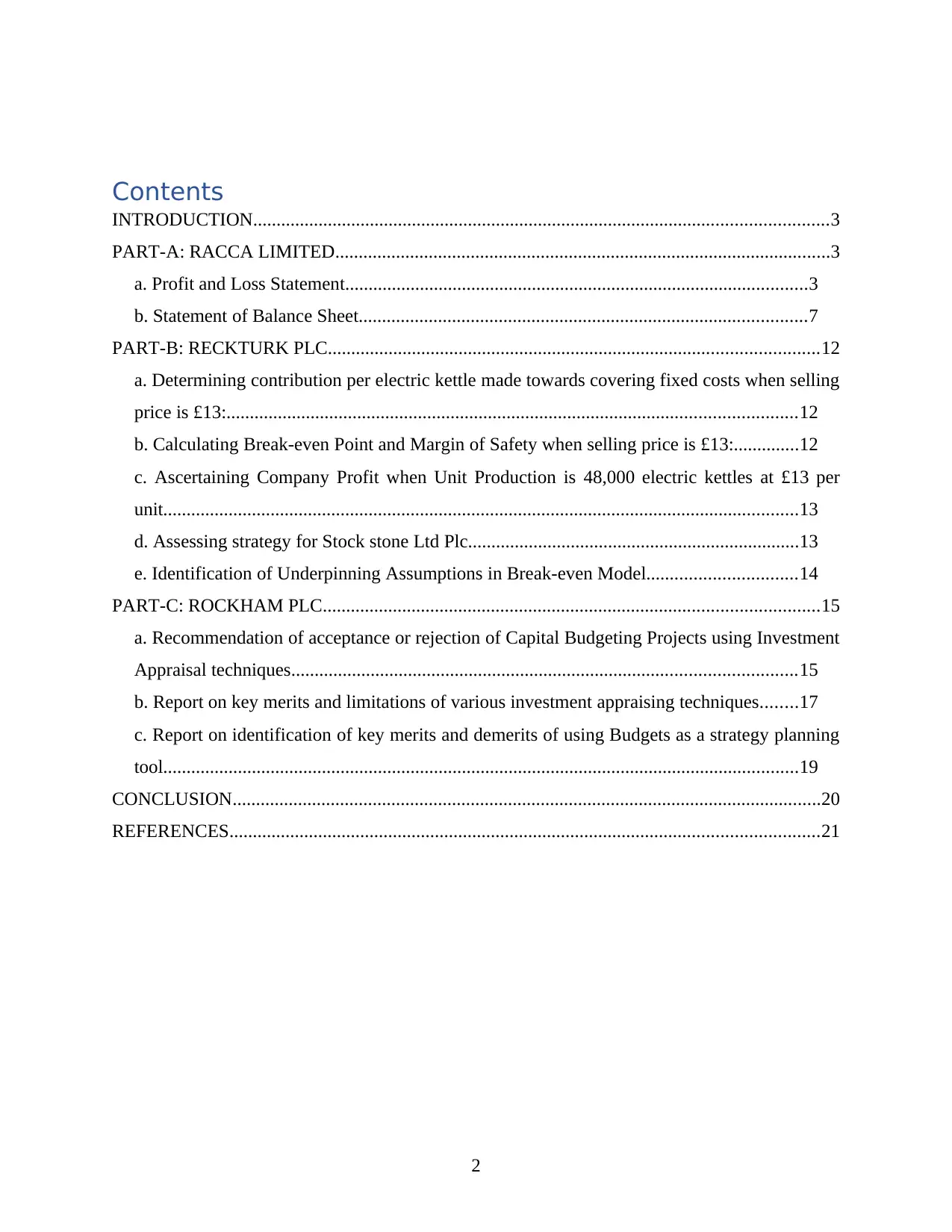
Contents
INTRODUCTION...........................................................................................................................3
PART-A: RACCA LIMITED..........................................................................................................3
a. Profit and Loss Statement...................................................................................................3
b. Statement of Balance Sheet................................................................................................7
PART-B: RECKTURK PLC.........................................................................................................12
a. Determining contribution per electric kettle made towards covering fixed costs when selling
price is £13:..........................................................................................................................12
b. Calculating Break-even Point and Margin of Safety when selling price is £13:..............12
c. Ascertaining Company Profit when Unit Production is 48,000 electric kettles at £13 per
unit........................................................................................................................................13
d. Assessing strategy for Stock stone Ltd Plc.......................................................................13
e. Identification of Underpinning Assumptions in Break-even Model................................14
PART-C: ROCKHAM PLC..........................................................................................................15
a. Recommendation of acceptance or rejection of Capital Budgeting Projects using Investment
Appraisal techniques............................................................................................................15
b. Report on key merits and limitations of various investment appraising techniques........17
c. Report on identification of key merits and demerits of using Budgets as a strategy planning
tool........................................................................................................................................19
CONCLUSION..............................................................................................................................20
REFERENCES..............................................................................................................................21
2
INTRODUCTION...........................................................................................................................3
PART-A: RACCA LIMITED..........................................................................................................3
a. Profit and Loss Statement...................................................................................................3
b. Statement of Balance Sheet................................................................................................7
PART-B: RECKTURK PLC.........................................................................................................12
a. Determining contribution per electric kettle made towards covering fixed costs when selling
price is £13:..........................................................................................................................12
b. Calculating Break-even Point and Margin of Safety when selling price is £13:..............12
c. Ascertaining Company Profit when Unit Production is 48,000 electric kettles at £13 per
unit........................................................................................................................................13
d. Assessing strategy for Stock stone Ltd Plc.......................................................................13
e. Identification of Underpinning Assumptions in Break-even Model................................14
PART-C: ROCKHAM PLC..........................................................................................................15
a. Recommendation of acceptance or rejection of Capital Budgeting Projects using Investment
Appraisal techniques............................................................................................................15
b. Report on key merits and limitations of various investment appraising techniques........17
c. Report on identification of key merits and demerits of using Budgets as a strategy planning
tool........................................................................................................................................19
CONCLUSION..............................................................................................................................20
REFERENCES..............................................................................................................................21
2
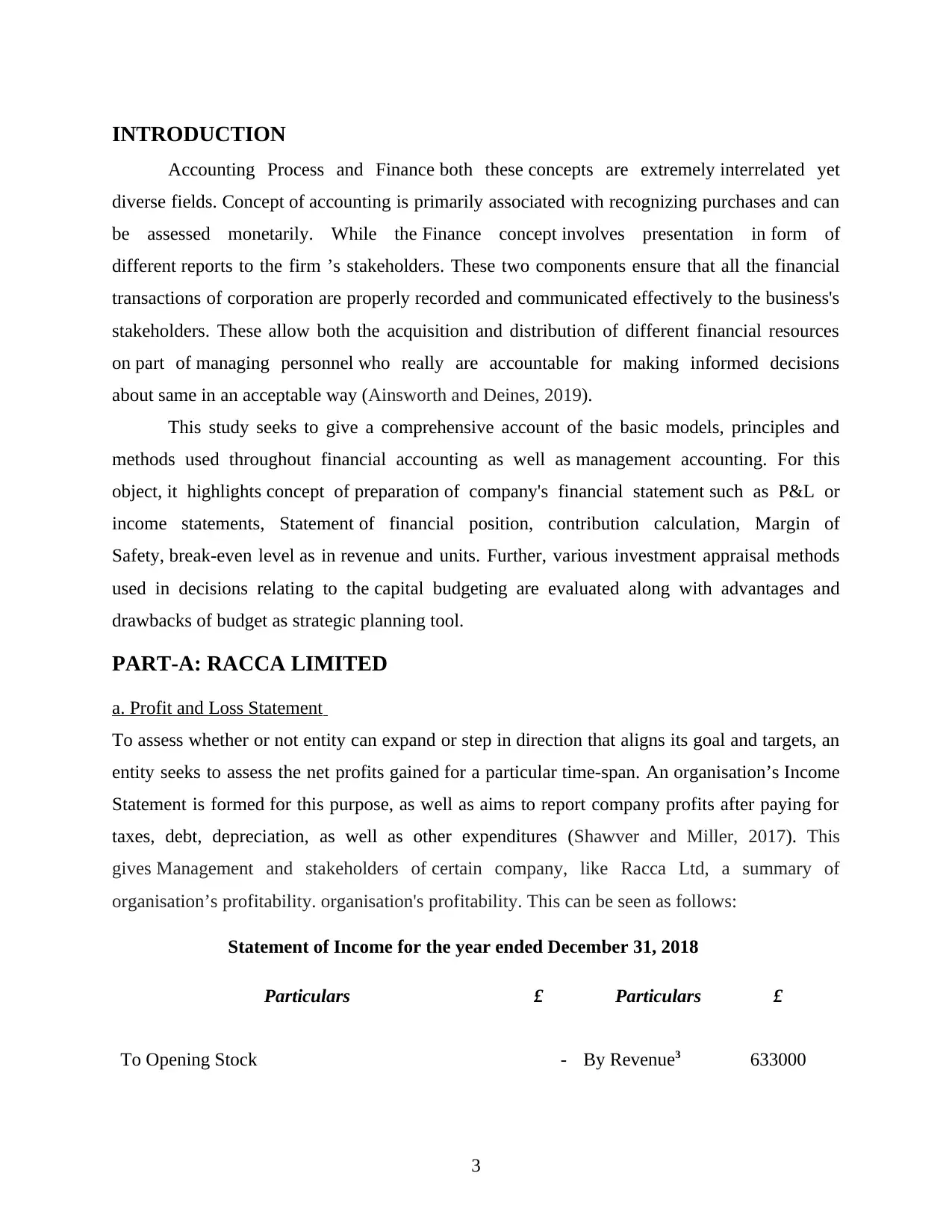
INTRODUCTION
Accounting Process and Finance both these concepts are extremely interrelated yet
diverse fields. Concept of accounting is primarily associated with recognizing purchases and can
be assessed monetarily. While the Finance concept involves presentation in form of
different reports to the firm ’s stakeholders. These two components ensure that all the financial
transactions of corporation are properly recorded and communicated effectively to the business's
stakeholders. These allow both the acquisition and distribution of different financial resources
on part of managing personnel who really are accountable for making informed decisions
about same in an acceptable way (Ainsworth and Deines, 2019).
This study seeks to give a comprehensive account of the basic models, principles and
methods used throughout financial accounting as well as management accounting. For this
object, it highlights concept of preparation of company's financial statement such as P&L or
income statements, Statement of financial position, contribution calculation, Margin of
Safety, break-even level as in revenue and units. Further, various investment appraisal methods
used in decisions relating to the capital budgeting are evaluated along with advantages and
drawbacks of budget as strategic planning tool.
PART-A: RACCA LIMITED
a. Profit and Loss Statement
To assess whether or not entity can expand or step in direction that aligns its goal and targets, an
entity seeks to assess the net profits gained for a particular time-span. An organisation’s Income
Statement is formed for this purpose, as well as aims to report company profits after paying for
taxes, debt, depreciation, as well as other expenditures (Shawver and Miller, 2017). This
gives Management and stakeholders of certain company, like Racca Ltd, a summary of
organisation’s profitability. organisation's profitability. This can be seen as follows:
Statement of Income for the year ended December 31, 2018
Particulars £ Particulars £
To Opening Stock - By Revenue3 633000
3
Accounting Process and Finance both these concepts are extremely interrelated yet
diverse fields. Concept of accounting is primarily associated with recognizing purchases and can
be assessed monetarily. While the Finance concept involves presentation in form of
different reports to the firm ’s stakeholders. These two components ensure that all the financial
transactions of corporation are properly recorded and communicated effectively to the business's
stakeholders. These allow both the acquisition and distribution of different financial resources
on part of managing personnel who really are accountable for making informed decisions
about same in an acceptable way (Ainsworth and Deines, 2019).
This study seeks to give a comprehensive account of the basic models, principles and
methods used throughout financial accounting as well as management accounting. For this
object, it highlights concept of preparation of company's financial statement such as P&L or
income statements, Statement of financial position, contribution calculation, Margin of
Safety, break-even level as in revenue and units. Further, various investment appraisal methods
used in decisions relating to the capital budgeting are evaluated along with advantages and
drawbacks of budget as strategic planning tool.
PART-A: RACCA LIMITED
a. Profit and Loss Statement
To assess whether or not entity can expand or step in direction that aligns its goal and targets, an
entity seeks to assess the net profits gained for a particular time-span. An organisation’s Income
Statement is formed for this purpose, as well as aims to report company profits after paying for
taxes, debt, depreciation, as well as other expenditures (Shawver and Miller, 2017). This
gives Management and stakeholders of certain company, like Racca Ltd, a summary of
organisation’s profitability. organisation's profitability. This can be seen as follows:
Statement of Income for the year ended December 31, 2018
Particulars £ Particulars £
To Opening Stock - By Revenue3 633000
3
⊘ This is a preview!⊘
Do you want full access?
Subscribe today to unlock all pages.

Trusted by 1+ million students worldwide
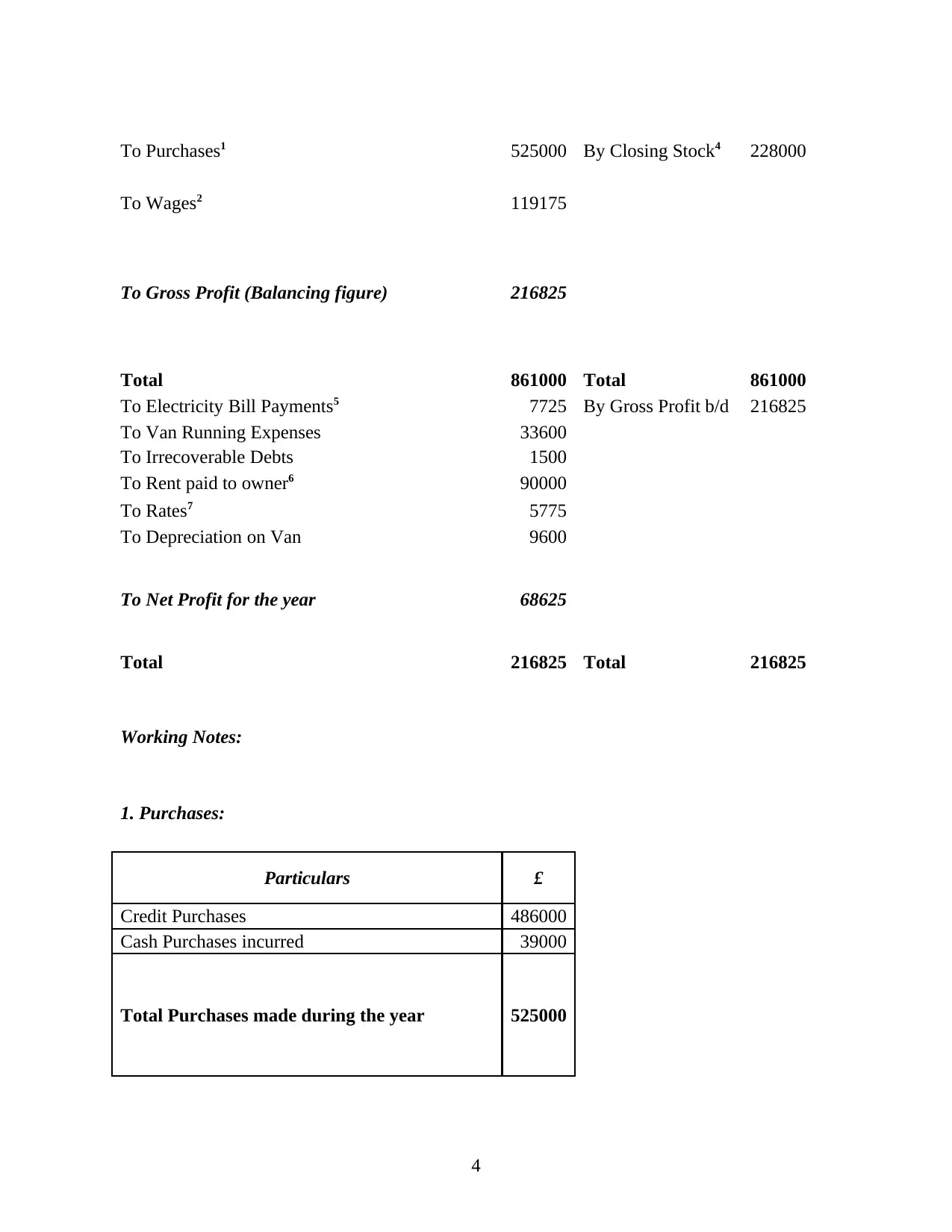
To Purchases1 525000 By Closing Stock4 228000
To Wages2 119175
To Gross Profit (Balancing figure) 216825
Total 861000 Total 861000
To Electricity Bill Payments5 7725 By Gross Profit b/d 216825
To Van Running Expenses 33600
To Irrecoverable Debts 1500
To Rent paid to owner6 90000
To Rates7 5775
To Depreciation on Van 9600
To Net Profit for the year 68625
Total 216825 Total 216825
Working Notes:
1. Purchases:
Particulars £
Credit Purchases 486000
Cash Purchases incurred 39000
Total Purchases made during the year 525000
4
To Wages2 119175
To Gross Profit (Balancing figure) 216825
Total 861000 Total 861000
To Electricity Bill Payments5 7725 By Gross Profit b/d 216825
To Van Running Expenses 33600
To Irrecoverable Debts 1500
To Rent paid to owner6 90000
To Rates7 5775
To Depreciation on Van 9600
To Net Profit for the year 68625
Total 216825 Total 216825
Working Notes:
1. Purchases:
Particulars £
Credit Purchases 486000
Cash Purchases incurred 39000
Total Purchases made during the year 525000
4
Paraphrase This Document
Need a fresh take? Get an instant paraphrase of this document with our AI Paraphraser
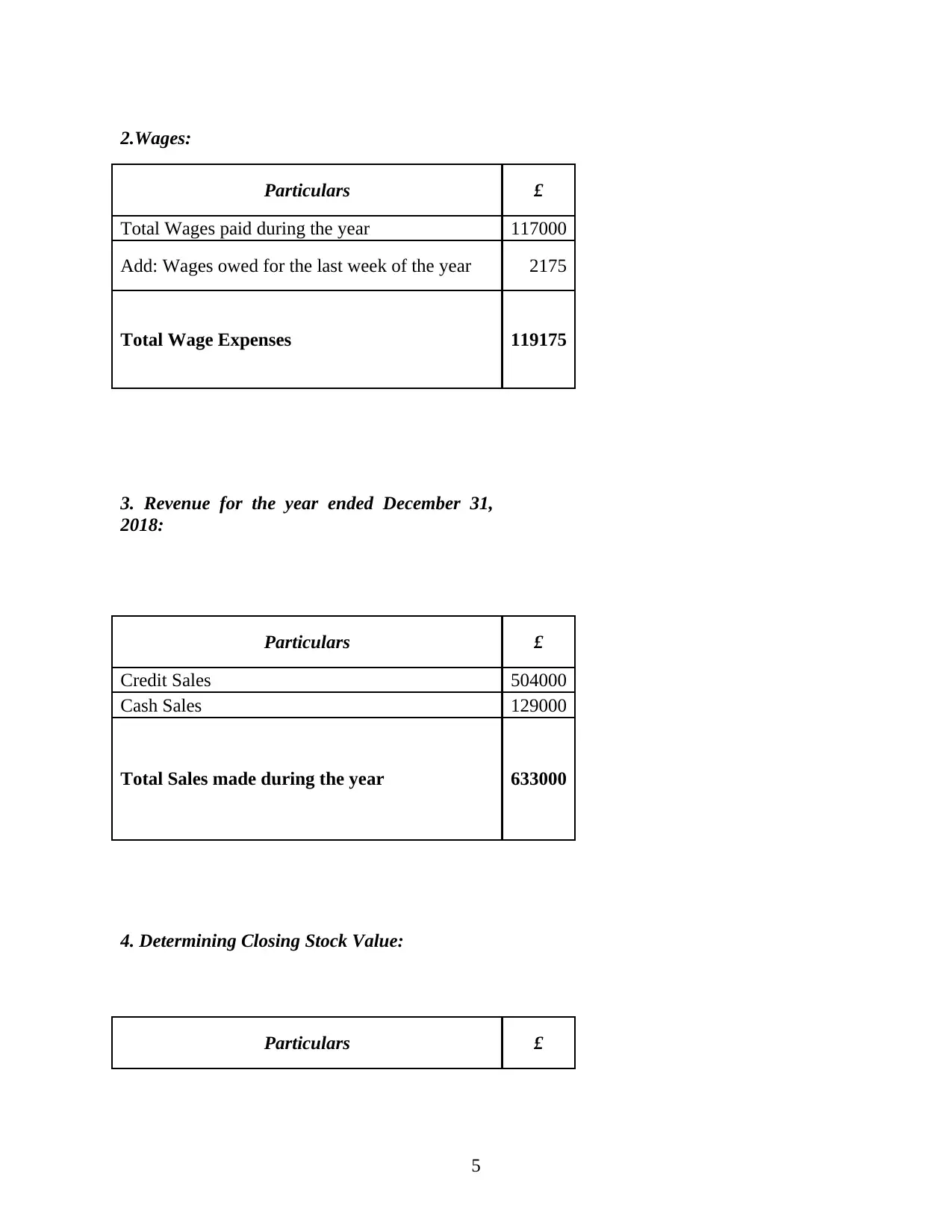
2.Wages:
Particulars £
Total Wages paid during the year 117000
Add: Wages owed for the last week of the year 2175
Total Wage Expenses 119175
3. Revenue for the year ended December 31,
2018:
Particulars £
Credit Sales 504000
Cash Sales 129000
Total Sales made during the year 633000
4. Determining Closing Stock Value:
Particulars £
5
Particulars £
Total Wages paid during the year 117000
Add: Wages owed for the last week of the year 2175
Total Wage Expenses 119175
3. Revenue for the year ended December 31,
2018:
Particulars £
Credit Sales 504000
Cash Sales 129000
Total Sales made during the year 633000
4. Determining Closing Stock Value:
Particulars £
5
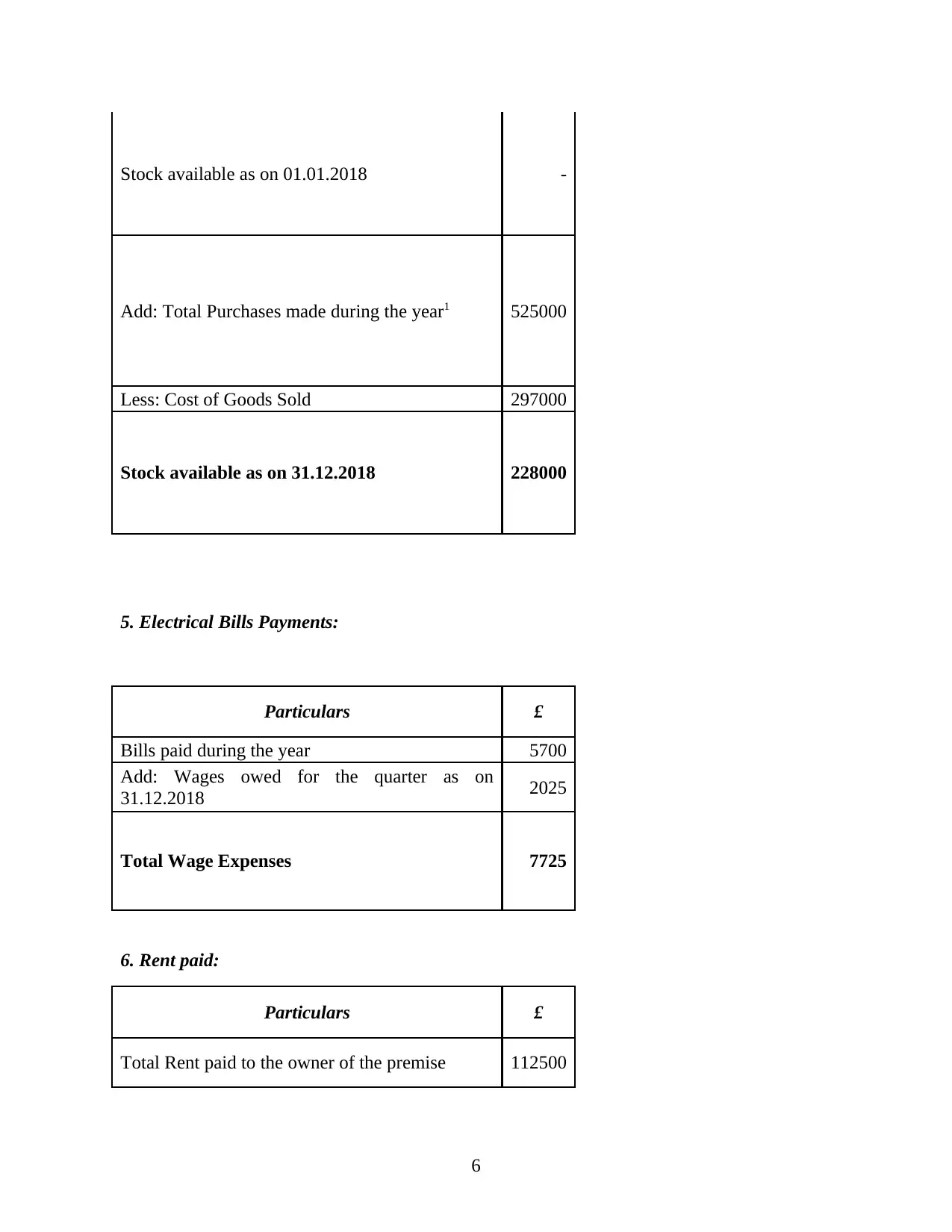
Stock available as on 01.01.2018 -
Add: Total Purchases made during the year1 525000
Less: Cost of Goods Sold 297000
Stock available as on 31.12.2018 228000
5. Electrical Bills Payments:
Particulars £
Bills paid during the year 5700
Add: Wages owed for the quarter as on
31.12.2018 2025
Total Wage Expenses 7725
6. Rent paid:
Particulars £
Total Rent paid to the owner of the premise 112500
6
Add: Total Purchases made during the year1 525000
Less: Cost of Goods Sold 297000
Stock available as on 31.12.2018 228000
5. Electrical Bills Payments:
Particulars £
Bills paid during the year 5700
Add: Wages owed for the quarter as on
31.12.2018 2025
Total Wage Expenses 7725
6. Rent paid:
Particulars £
Total Rent paid to the owner of the premise 112500
6
⊘ This is a preview!⊘
Do you want full access?
Subscribe today to unlock all pages.

Trusted by 1+ million students worldwide
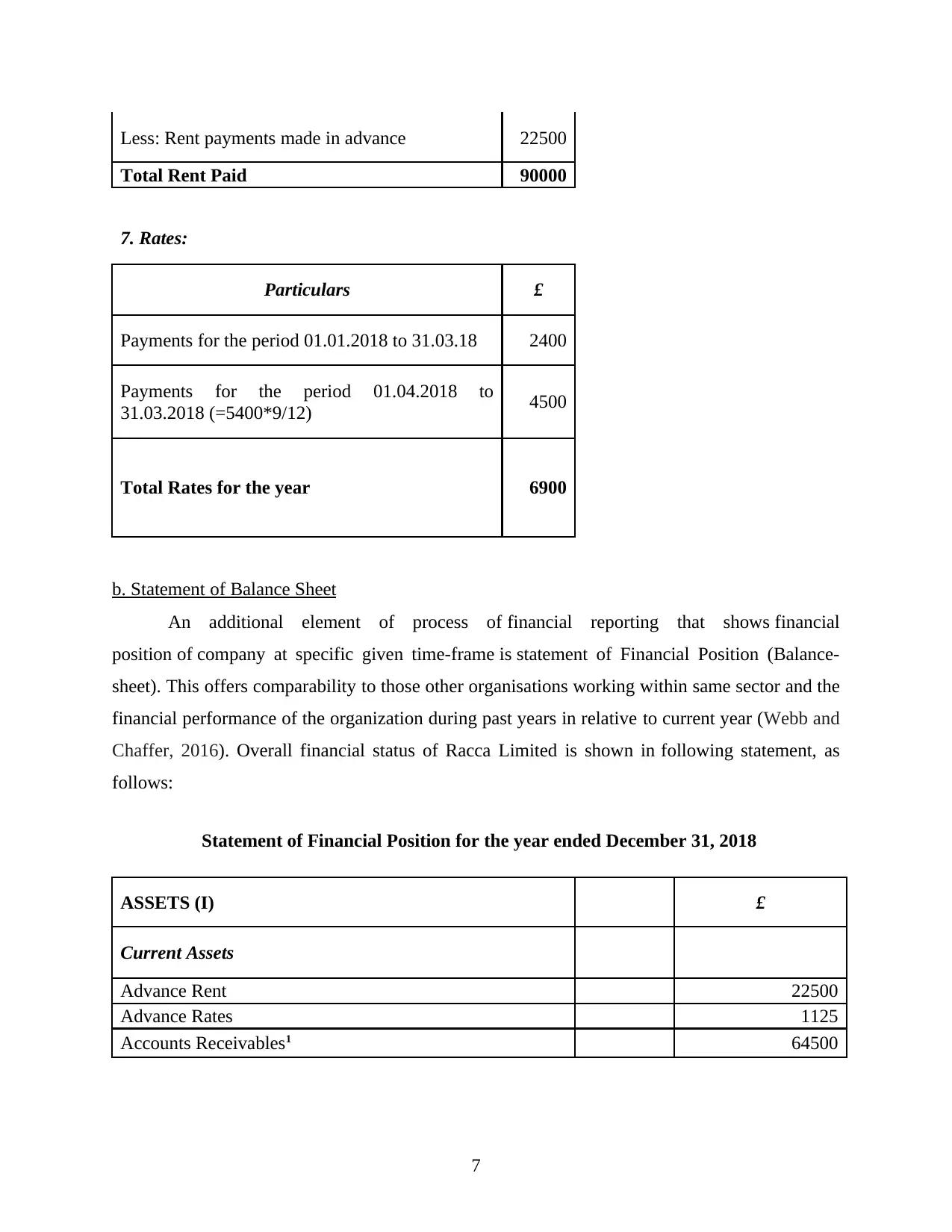
Less: Rent payments made in advance 22500
Total Rent Paid 90000
7. Rates:
Particulars £
Payments for the period 01.01.2018 to 31.03.18 2400
Payments for the period 01.04.2018 to
31.03.2018 (=5400*9/12) 4500
Total Rates for the year 6900
b. Statement of Balance Sheet
An additional element of process of financial reporting that shows financial
position of company at specific given time-frame is statement of Financial Position (Balance-
sheet). This offers comparability to those other organisations working within same sector and the
financial performance of the organization during past years in relative to current year (Webb and
Chaffer, 2016). Overall financial status of Racca Limited is shown in following statement, as
follows:
Statement of Financial Position for the year ended December 31, 2018
ASSETS (I) £
Current Assets
Advance Rent 22500
Advance Rates 1125
Accounts Receivables1 64500
7
Total Rent Paid 90000
7. Rates:
Particulars £
Payments for the period 01.01.2018 to 31.03.18 2400
Payments for the period 01.04.2018 to
31.03.2018 (=5400*9/12) 4500
Total Rates for the year 6900
b. Statement of Balance Sheet
An additional element of process of financial reporting that shows financial
position of company at specific given time-frame is statement of Financial Position (Balance-
sheet). This offers comparability to those other organisations working within same sector and the
financial performance of the organization during past years in relative to current year (Webb and
Chaffer, 2016). Overall financial status of Racca Limited is shown in following statement, as
follows:
Statement of Financial Position for the year ended December 31, 2018
ASSETS (I) £
Current Assets
Advance Rent 22500
Advance Rates 1125
Accounts Receivables1 64500
7
Paraphrase This Document
Need a fresh take? Get an instant paraphrase of this document with our AI Paraphraser
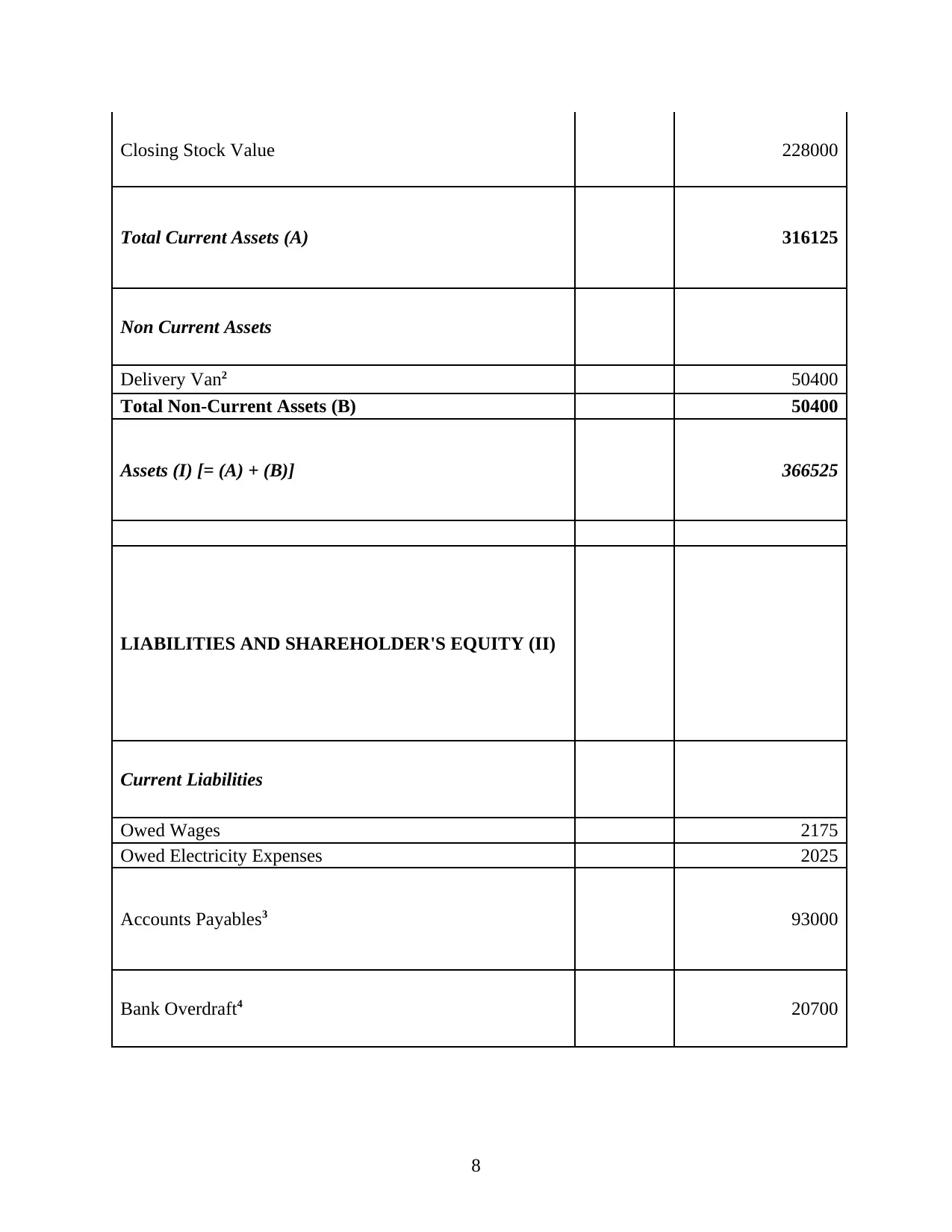
Closing Stock Value 228000
Total Current Assets (A) 316125
Non Current Assets
Delivery Van2 50400
Total Non-Current Assets (B) 50400
Assets (I) [= (A) + (B)] 366525
LIABILITIES AND SHAREHOLDER'S EQUITY (II)
Current Liabilities
Owed Wages 2175
Owed Electricity Expenses 2025
Accounts Payables3 93000
Bank Overdraft4 20700
8
Total Current Assets (A) 316125
Non Current Assets
Delivery Van2 50400
Total Non-Current Assets (B) 50400
Assets (I) [= (A) + (B)] 366525
LIABILITIES AND SHAREHOLDER'S EQUITY (II)
Current Liabilities
Owed Wages 2175
Owed Electricity Expenses 2025
Accounts Payables3 93000
Bank Overdraft4 20700
8
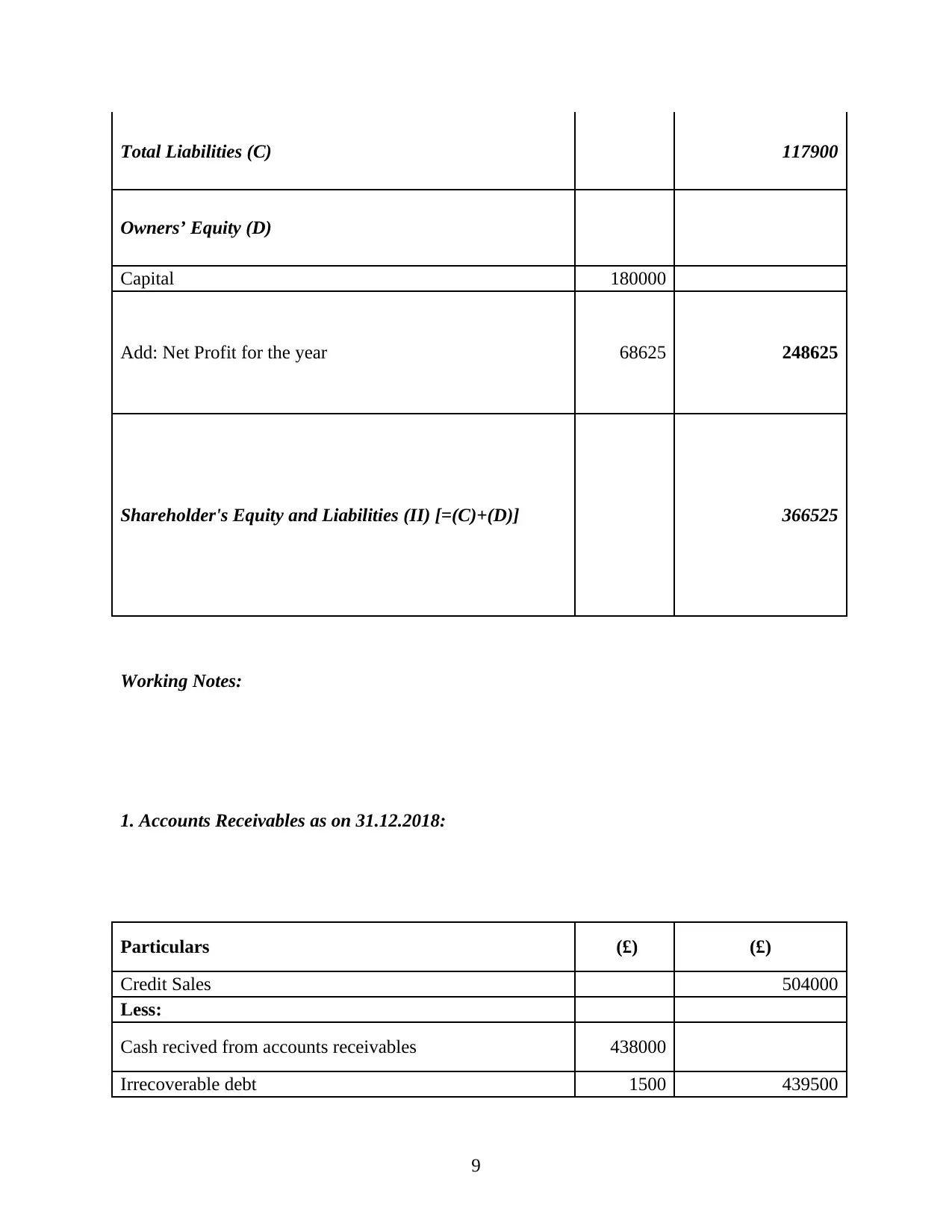
Total Liabilities (C) 117900
Owners’ Equity (D)
Capital 180000
Add: Net Profit for the year 68625 248625
Shareholder's Equity and Liabilities (II) [=(C)+(D)] 366525
Working Notes:
1. Accounts Receivables as on 31.12.2018:
Particulars (£) (£)
Credit Sales 504000
Less:
Cash recived from accounts receivables 438000
Irrecoverable debt 1500 439500
9
Owners’ Equity (D)
Capital 180000
Add: Net Profit for the year 68625 248625
Shareholder's Equity and Liabilities (II) [=(C)+(D)] 366525
Working Notes:
1. Accounts Receivables as on 31.12.2018:
Particulars (£) (£)
Credit Sales 504000
Less:
Cash recived from accounts receivables 438000
Irrecoverable debt 1500 439500
9
⊘ This is a preview!⊘
Do you want full access?
Subscribe today to unlock all pages.

Trusted by 1+ million students worldwide
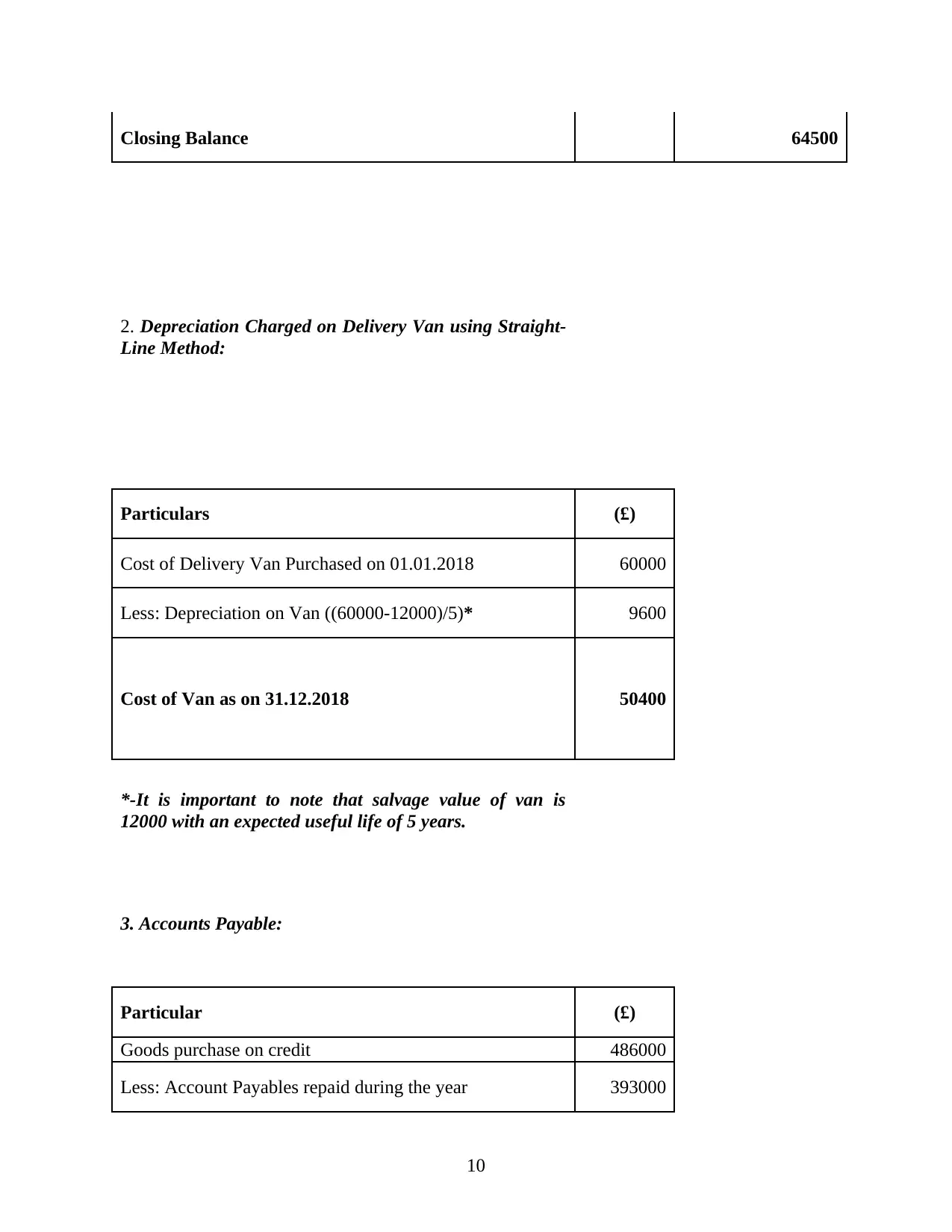
Closing Balance 64500
2. Depreciation Charged on Delivery Van using Straight-
Line Method:
Particulars (£)
Cost of Delivery Van Purchased on 01.01.2018 60000
Less: Depreciation on Van ((60000-12000)/5)* 9600
Cost of Van as on 31.12.2018 50400
*-It is important to note that salvage value of van is
12000 with an expected useful life of 5 years.
3. Accounts Payable:
Particular (£)
Goods purchase on credit 486000
Less: Account Payables repaid during the year 393000
10
2. Depreciation Charged on Delivery Van using Straight-
Line Method:
Particulars (£)
Cost of Delivery Van Purchased on 01.01.2018 60000
Less: Depreciation on Van ((60000-12000)/5)* 9600
Cost of Van as on 31.12.2018 50400
*-It is important to note that salvage value of van is
12000 with an expected useful life of 5 years.
3. Accounts Payable:
Particular (£)
Goods purchase on credit 486000
Less: Account Payables repaid during the year 393000
10
Paraphrase This Document
Need a fresh take? Get an instant paraphrase of this document with our AI Paraphraser
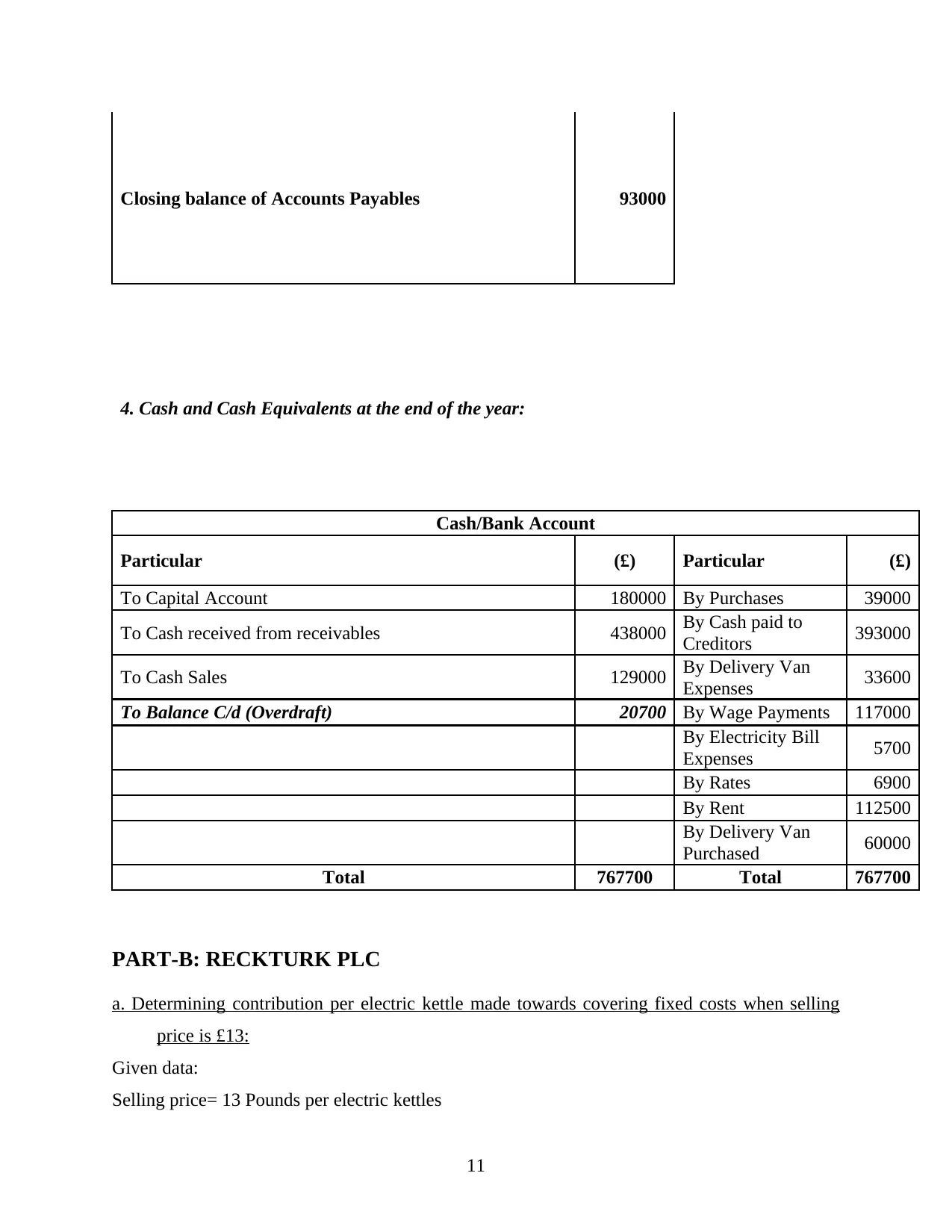
Closing balance of Accounts Payables 93000
4. Cash and Cash Equivalents at the end of the year:
Cash/Bank Account
Particular (£) Particular (£)
To Capital Account 180000 By Purchases 39000
To Cash received from receivables 438000 By Cash paid to
Creditors 393000
To Cash Sales 129000 By Delivery Van
Expenses 33600
To Balance C/d (Overdraft) 20700 By Wage Payments 117000
By Electricity Bill
Expenses 5700
By Rates 6900
By Rent 112500
By Delivery Van
Purchased 60000
Total 767700 Total 767700
PART-B: RECKTURK PLC
a. Determining contribution per electric kettle made towards covering fixed costs when selling
price is £13:
Given data:
Selling price= 13 Pounds per electric kettles
11
4. Cash and Cash Equivalents at the end of the year:
Cash/Bank Account
Particular (£) Particular (£)
To Capital Account 180000 By Purchases 39000
To Cash received from receivables 438000 By Cash paid to
Creditors 393000
To Cash Sales 129000 By Delivery Van
Expenses 33600
To Balance C/d (Overdraft) 20700 By Wage Payments 117000
By Electricity Bill
Expenses 5700
By Rates 6900
By Rent 112500
By Delivery Van
Purchased 60000
Total 767700 Total 767700
PART-B: RECKTURK PLC
a. Determining contribution per electric kettle made towards covering fixed costs when selling
price is £13:
Given data:
Selling price= 13 Pounds per electric kettles
11
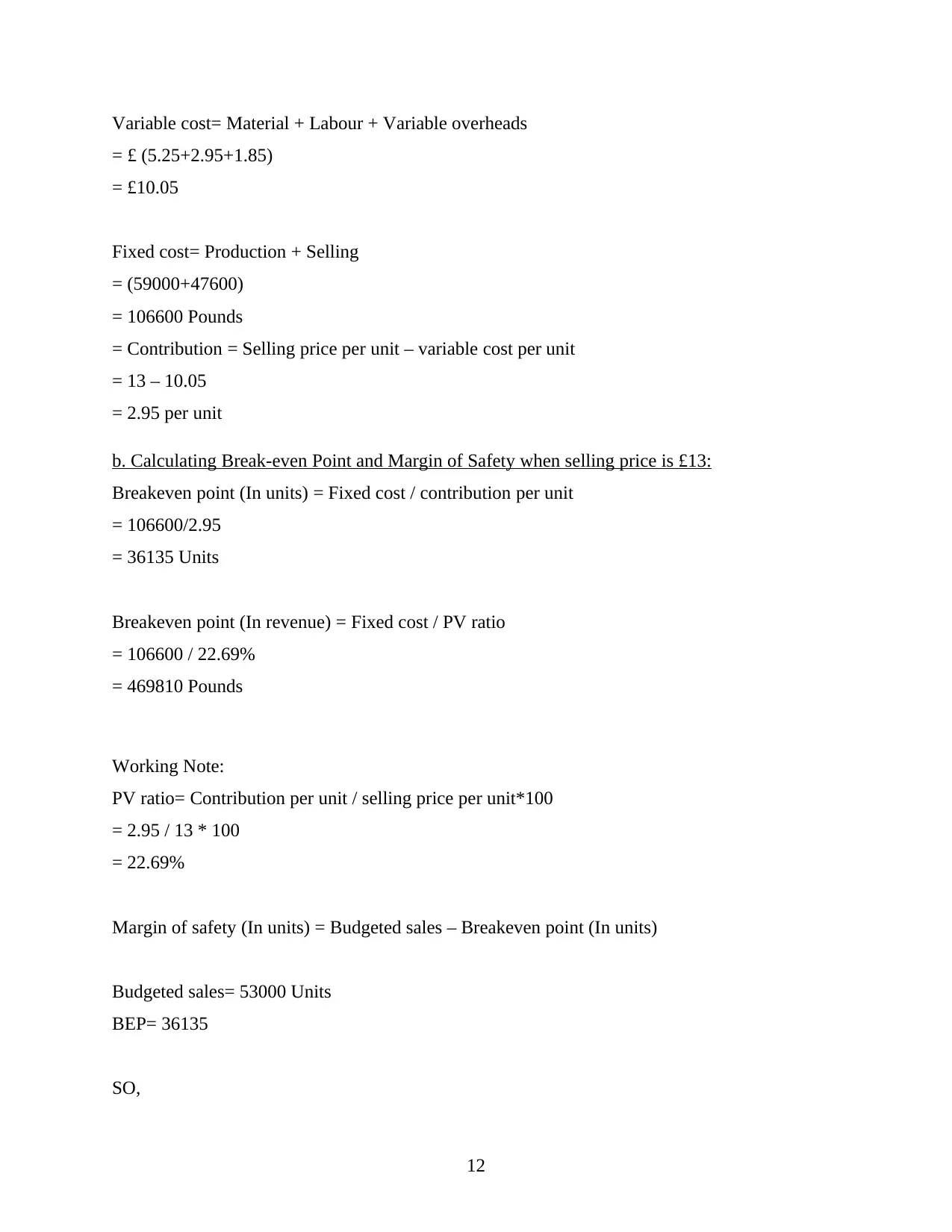
Variable cost= Material + Labour + Variable overheads
= £ (5.25+2.95+1.85)
= £10.05
Fixed cost= Production + Selling
= (59000+47600)
= 106600 Pounds
= Contribution = Selling price per unit – variable cost per unit
= 13 – 10.05
= 2.95 per unit
b. Calculating Break-even Point and Margin of Safety when selling price is £13:
Breakeven point (In units) = Fixed cost / contribution per unit
= 106600/2.95
= 36135 Units
Breakeven point (In revenue) = Fixed cost / PV ratio
= 106600 / 22.69%
= 469810 Pounds
Working Note:
PV ratio= Contribution per unit / selling price per unit*100
= 2.95 / 13 * 100
= 22.69%
Margin of safety (In units) = Budgeted sales – Breakeven point (In units)
Budgeted sales= 53000 Units
BEP= 36135
SO,
12
= £ (5.25+2.95+1.85)
= £10.05
Fixed cost= Production + Selling
= (59000+47600)
= 106600 Pounds
= Contribution = Selling price per unit – variable cost per unit
= 13 – 10.05
= 2.95 per unit
b. Calculating Break-even Point and Margin of Safety when selling price is £13:
Breakeven point (In units) = Fixed cost / contribution per unit
= 106600/2.95
= 36135 Units
Breakeven point (In revenue) = Fixed cost / PV ratio
= 106600 / 22.69%
= 469810 Pounds
Working Note:
PV ratio= Contribution per unit / selling price per unit*100
= 2.95 / 13 * 100
= 22.69%
Margin of safety (In units) = Budgeted sales – Breakeven point (In units)
Budgeted sales= 53000 Units
BEP= 36135
SO,
12
⊘ This is a preview!⊘
Do you want full access?
Subscribe today to unlock all pages.

Trusted by 1+ million students worldwide
1 out of 22
Related Documents
Your All-in-One AI-Powered Toolkit for Academic Success.
+13062052269
info@desklib.com
Available 24*7 on WhatsApp / Email
![[object Object]](/_next/static/media/star-bottom.7253800d.svg)
Unlock your academic potential
Copyright © 2020–2025 A2Z Services. All Rights Reserved. Developed and managed by ZUCOL.





